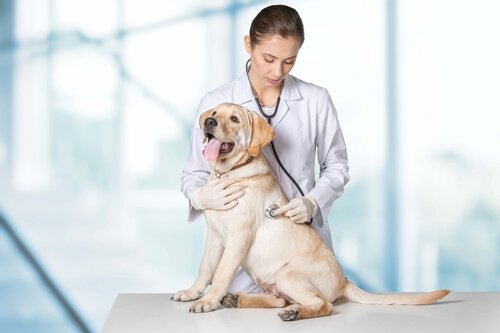Megaesophagus in Dogs: symptoms and treatment

Megaesophagus in dogs is a disease with a severe prognosis. In general, it affects dogs more than cats. Unfortunately, without proper treatment, this type of condition can cause a series of complications that can endanger your pet’s life.
What is megaesophagus in dogs?
This type of injury is defined as the dilation and loss of mobility of the esophagus, specifically the esophagus of dogs. This type of injury can make this organ completely lose the mobility it needs to swallow food and fluids.
Dilation of the esophagus is more common in large-sized breeds, such as the Great Dane, German Shepherds, or Labrador Retriever. Also, this can be a congenital disease, which means it can develop at the time of birth. However, the breeds that are most predisposed to being born with megaesophagus are the Wire-haired Fox Terrier and the Miniature Schnauzer.

Causes and Symptoms of Megaesophagus in Dogs
The most common symptom of megaesophagus in dogs is when they regurgitate their food right after eating or several hours later. Other symptoms are:
- Vomiting
- Coughing
- Nasal Secretions
- Increased noises while breathing
- Weight loss
- Abnormal increase in appetite or loss of appetite
- Bad breath
- Lack of growth
One of the most serious consequences of megaesophagus is aspiration pneumonia. This respiratory condition takes when food, saliva, fluids, or vomit are inhaled directly into the lungs.
Megaesophagus in dogs may be congenital, which means it can take place while the fetus develops. However, it can also be a secondary disease, be linked to other diseases or hereditary.
Some of the secondary causes of megaesophagus are the following:
- Neuromuscular diseases, such as myositis or myasthenia gravis
- Tumors in the esophagus
- The presence of a foreign object in the dog’s esophagus
- Inflammation of the esophagus
- Parasitic infections
Diagnosis and Treatment
Once the veterinarian read the animal’s clinical history, he/she will run a complete check-up and determine whether the dog tends to regurgitate or vomit, according to the information provided by the owner. By knowing these details, the vet could rule out other possible digestive diseases.

The shape, color, and presence of undigested solid particles in the dog’s vomit will also important for determining the diagnosis. In addition, other common tests are blood and urine samples, which allow the veterinarian to detect if there are any medical conditions.
An esophagoscopy will help the vet remove any foreign objects that have been lodged in your pet’s esophagus. Also, they can evaluate how much the esophagus is dilated.
As for the treatment, the main strategy is to try to cure the underlying disease in cases of secondary megaesophagus. However, in some cases, the dog may need surgery. Unfortunately, if your dog cannot eat, you will have to feed him through a nasogastric tube.
If your dog palliative treatment is purely palliative, which is quite common for treating congenital megaesophagus, you should turn your dog over about every four hours. Also, give them a soft mattress sleep on, and feed them a liquid diet.
Megaesophagus in dogs is a disease with a severe prognosis. In general, it affects dogs more than cats. Unfortunately, without proper treatment, this type of condition can cause a series of complications that can endanger your pet’s life.
What is megaesophagus in dogs?
This type of injury is defined as the dilation and loss of mobility of the esophagus, specifically the esophagus of dogs. This type of injury can make this organ completely lose the mobility it needs to swallow food and fluids.
Dilation of the esophagus is more common in large-sized breeds, such as the Great Dane, German Shepherds, or Labrador Retriever. Also, this can be a congenital disease, which means it can develop at the time of birth. However, the breeds that are most predisposed to being born with megaesophagus are the Wire-haired Fox Terrier and the Miniature Schnauzer.

Causes and Symptoms of Megaesophagus in Dogs
The most common symptom of megaesophagus in dogs is when they regurgitate their food right after eating or several hours later. Other symptoms are:
- Vomiting
- Coughing
- Nasal Secretions
- Increased noises while breathing
- Weight loss
- Abnormal increase in appetite or loss of appetite
- Bad breath
- Lack of growth
One of the most serious consequences of megaesophagus is aspiration pneumonia. This respiratory condition takes when food, saliva, fluids, or vomit are inhaled directly into the lungs.
Megaesophagus in dogs may be congenital, which means it can take place while the fetus develops. However, it can also be a secondary disease, be linked to other diseases or hereditary.
Some of the secondary causes of megaesophagus are the following:
- Neuromuscular diseases, such as myositis or myasthenia gravis
- Tumors in the esophagus
- The presence of a foreign object in the dog’s esophagus
- Inflammation of the esophagus
- Parasitic infections
Diagnosis and Treatment
Once the veterinarian read the animal’s clinical history, he/she will run a complete check-up and determine whether the dog tends to regurgitate or vomit, according to the information provided by the owner. By knowing these details, the vet could rule out other possible digestive diseases.

The shape, color, and presence of undigested solid particles in the dog’s vomit will also important for determining the diagnosis. In addition, other common tests are blood and urine samples, which allow the veterinarian to detect if there are any medical conditions.
An esophagoscopy will help the vet remove any foreign objects that have been lodged in your pet’s esophagus. Also, they can evaluate how much the esophagus is dilated.
As for the treatment, the main strategy is to try to cure the underlying disease in cases of secondary megaesophagus. However, in some cases, the dog may need surgery. Unfortunately, if your dog cannot eat, you will have to feed him through a nasogastric tube.
If your dog palliative treatment is purely palliative, which is quite common for treating congenital megaesophagus, you should turn your dog over about every four hours. Also, give them a soft mattress sleep on, and feed them a liquid diet.
All cited sources were thoroughly reviewed by our team to ensure their quality, reliability, currency, and validity. The bibliography of this article was considered reliable and of academic or scientific accuracy.
- Bexfield, N. H., Watson, P. J., & Herrtage, M. E. (2006). Esophageal dysmotility in young dogs. Journal of Veterinary Internal Medicine. https://doi.org/10.1892/0891-6640(2006)20[1314:EDIYD]2.0.CO;2
This text is provided for informational purposes only and does not replace consultation with a professional. If in doubt, consult your specialist.







